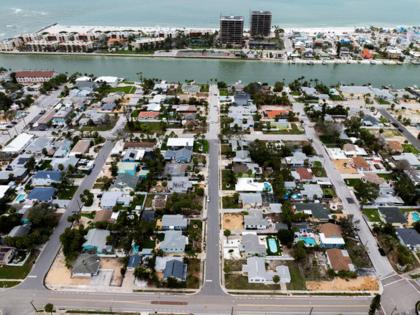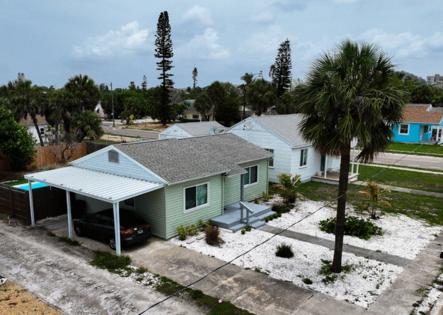Investors snapped up Tampa Bay homes damaged by hurricanes Helene and Milton
Published in Business News
Ann Haendel lived happily in her St. Pete Beach, Florida, home for more than 30 years before Helene sent 3 feet of water into the two-bedroom cottage.
When she returned after evacuating, the place looked “like a tornado had ripped through,” she said. Furniture was upturned and books lay sopping on the floor.
The city determined that the cost of the damage — which Haendel estimated to be well over $100,000 — exceeded half the home’s value. In keeping with federal guidelines, that meant Haendel’s house was “substantially damaged.” She would need to rebuild from scratch or elevate the property.
At 89, she said, it didn’t make sense to do that. So when a company called HomeGo offered her a little over $250,000 for the house — almost triple what she paid — she sold and moved in with her daughter in California.
Haendel’s home wasn’t the only one that HomeGo purchased in Tampa Bay after last year’s historic storm season. An LLC tied to that company bought at least 58 others, deed records show.
To understand how hurricanes Helene and Milton reshaped the local real estate market, the Tampa Bay Times analyzed thousands of residential sales records in Hillsborough and Pinellas counties from October through March.
The analysis found LLCs bought more than a quarter of the 3,300 properties that sold in areas inundated by significant storm surge.
The share of homes in those areas that sold to a company instead of to an individual more than doubled over the six months after Hurricane Helene. In areas with minimal or no surge at all, the share stayed about the same.
It’s a familiar trend after natural disasters, experts say, as residents buckle under the financial strain of repairs and the emotional toll of living in a high-risk area.
In many cases, “folks sort of just threw up their hands and said, ‘We don’t care, we’re leaving,’” said Susan Heffron, a vice president at the real estate analytics firm Zonda. That depresses prices, she said, creating opportunities for investors, developers and flippers.
Investors have the cash reserves to improve properties and make them more resilient. One developer who bought 30 storm-damaged homes in South Tampa said he planned to demolish the existing structures and build homes that could better withstand rising sea levels and stronger hurricanes.
But other buyers appear to be flipping storm-damaged properties without the necessary permits, raising concerns about the quality of the work.
What’s more, storm-ravaged neighborhoods typically become more expensive to live in after older homes get replaced with new, more expensive ones.
“For a home to have been rehabbed ... you’re going to have additional costs,” Heffron said.
How did Helene and Milton impact home sales?
Nearly a thousand sales analyzed by the Times involved a home that sustained storm damage, according to a review of construction permits, substantial damage letters issued by local governments and code enforcement records. But since municipalities don’t uniformly track storm-damaged properties, the tally could be higher.
Heffron estimates that about 7% of homes, apartments and condo units in the region were damaged. This led to a lull in the market as buyers and sellers waited for the dust to settle.
But by December, listings jumped by about 26% compared to the previous year.
The Times found that over the six months after Hurricane Helene, some of the most flooded parts of Pinellas County saw an uptick in sales. This included Shore Acres, Gulfport and the barrier islands.
Communities with the most flooding had about 8% more sales after Helene than they did during the same period the year before. By contrast, sales across the rest of the county dipped by 8%.
In Hillsborough County, where there was less storm surge, real estate trends in flooded areas did not diverge much from places that stayed dry.
“We always worry that there’s going to be a stigma put on Florida every time we have a bad hurricane, and it just doesn’t seem to materialize,” said Brad O’Connor, chief economist at Florida Realtors. “People still want to move here. People still want to live in paradise.”
Older homeowners are more likely to sell after a disaster, said Heffron. For many, sinking thousands of dollars into a home you may only live in for a few more years doesn’t feel like a worthwhile investment. Others are weary from weathering storm after storm and see an opportunity to cash out after years of building equity.
After their Treasure Island home flooded during Helene, Carol Crane and her husband spent six months weighing whether they should sell.
But at 77, she said they were exhausted by the prospect of rebuilding.
“Every year, there were two or three evacuations off the island, which was a lot of work,” she said. “We just finally decided that we needed something simpler and safer.”
They recently bought a home in The Villages — 40 miles from the nearest coast.
A gold mine for investors
Natural disasters provide a rare opportunity for investors to get a foothold in desirable neighborhoods for well below the market rate.
In the most-flooded areas, the Times identified nearly a thousand homes that were purchased by LLCs or corporations following Helene and Milton.
These buyers can be difficult to identify. Unlike the institutional investors backed by Wall Street and private equity funds that now own more than 27,000 homes across Tampa Bay, many flippers create unique LLCs for each property they buy and register the company to the home’s address instead of a business address. When the home is sold, the LLC dissolves.
Jorge Vasquez, CEO of Tampa-based Graystone Investment Group, said he saw investment activity in Tampa Bay pick up around February, after months of hesitation due to high interest rates and the immediate aftermath of the storms.
In a blog post from October, he wrote that distressed properties could be flipped or converted into rentals, making them a “goldmine” for investors.
Buyers are now weighing the potential for profit in beachfront properties with the possibility of future flooding. Some are drawn to the beaches for the chance to have a short-term rental property that could double as a vacation spot.
But many, Vasquez said, are waiting to see how this year’s season plays out. They want to know if the repeated storms thrashing the Gulf Coast in recent years are the new normal.
“Remember, for investors, it’s all about the risk tolerance, right?” Vazquez said.
Lysette Ketterer, a real estate agent with Century 21 who specializes in waterfront properties, said she fielded calls from investors after the storms.
She turns them away, advising her sellers not to take a low-ball offer.
“Initially, you have that scare tactic,” she said. “People act on emotion. … Some people sold for a really low price up front.”
She helped Crane and her husband find a buyer who was willing to make repairs. The couple walked away with $875,000 — about $250,000 more than they paid in 2008.
People who waited to sell fared better. In the areas that flooded the most, prices swiftly dropped after Hurricane Helene. In August 2024, excluding gift sales and transfers among family members, homes in surge areas went for a median price of $754,000. By February, the median price had slipped to $445,000.
Prices have started to recover but haven’t reached pre-storm levels.
What happened to all those storm-damaged homes?
Investors with cash are prepared to sink costs into expensive storm repairs, but the average homeowner might not have the same wherewithal.
“They just want to start a new chapter and they just want to get on with their lives,” said Mark Bogue, owner of the local investment firm Property Solutions of Tampa Bay. His company has bought and remodeled hundreds of hurricane-battered homes since the late ’90s.
Oftentimes, investors will buy a substantially damaged home and then get that determination reversed by proving the cost of repairs adds up to less than half of the home’s value. This allows them to renovate without elevating.
It’s something Bogue has done repeatedly post-Helene — none of the homes Property Solutions of Tampa Bay purchased after last year’s storms had to be torn down, he said.
Haendel thought her St. Pete Beach home would be demolished after she sold it to HomeGo, a subsidiary of the Texas-based investment firm New Western.
That didn’t happen.
Instead, HomeGo sold her house again less than two weeks later. Property records show that Dematteo Investments LLC paid $300,000 for the property in December.
Haendel discovered pictures of the freshly renovated home when Dematteo Investments LLC listed it for rent in February.
Gone were the special touches she added over the years. The cabinets she installed had been torn out. Her lush backyard was replaced with bright green artificial turf.
Andrea Merrill, New Western’s vice president of marketing, said HomeGo does not rehab any of the properties it buys. The company connects flippers like DeMatteo Investments LLC with distressed properties like Haendel’s home.
A spokesperson for St. Pete Beach said the home is still considered substantially damaged and that no work permits have been filed. But when a Times reporter visited the home in June, someone was renting it from DeMatteo Investments LLC.
The owner of that company, St. Petersburg resident Nicholas R. DeMatteo, could not be reached for comment.
How are hurricanes changing our neighborhoods?
Haendel’s home is one of at least 10 on her block that have come under new ownership since October.
The neighborhood remains in flux. Several homes appear vacant. Signs advertising demolition companies are planted in lawns. Water-stained walls show where the tide rushed in.
There are examples like this scattered across Tampa Bay, entire streets that have turned over since last hurricane season.
“The faces of those neighborhoods are going to change,” said Willy Nunn, the CEO of Homes By WestBay.
His company bought more than 30 properties in South Tampa that will be demolished.
“The homes that we’re buying, we’re buying for around $700,000,” Nunn said. “The homes that we’re building are going to be over $2 million. … It could generate an affordability issue.”
Data from past hurricanes has shown that areas that suffer the most storm damage face steeper price increases. Repairs often increase the home’s resiliency and its value.
Nunn said it is up to local governments to find solutions to preserve affordability after a major storm. He suggested loosening zoning to allow more homes to be built on storm-damaged lots.
Vazquez believes the region’s potential for investment activity has barely begun. If no major storms cause harm to Tampa Bay, by the end of the 2025 season, buyers will come in droves.
“The floodgates will open,” he predicted. “Every investor and their mother is going to come and invest here in Florida. They just want to know whether this was a one-off.”
©2025 Tampa Bay Times. Visit at tampabay.com. Distributed by Tribune Content Agency, LLC.















Comments